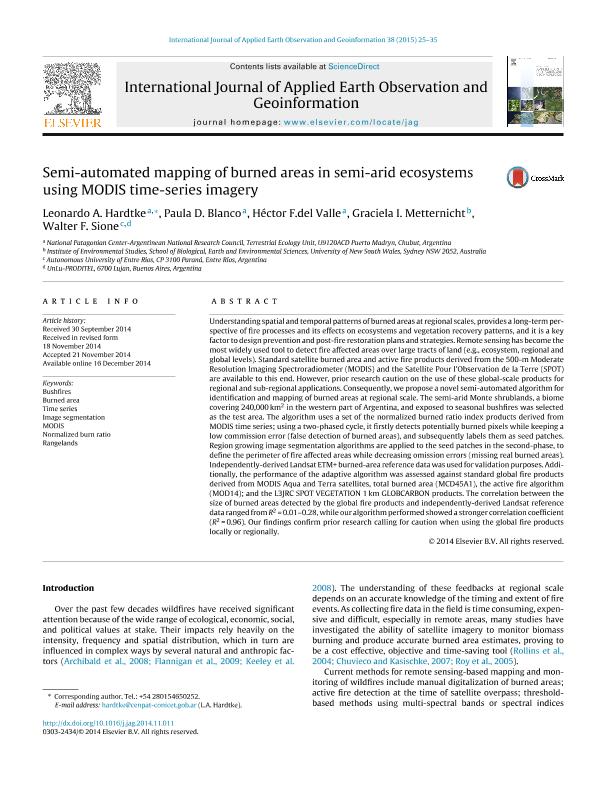Mostrar el registro sencillo del ítem
dc.contributor.author
Hardtke, Leonardo Andrés

dc.contributor.author
Blanco, Paula Daniela

dc.contributor.author
del Valle, Hector Francisco

dc.contributor.author
Metternicht, Graciela

dc.contributor.author
Sione, Walter Fabian

dc.date.available
2018-03-20T16:03:37Z
dc.date.issued
2015-12
dc.identifier.citation
Hardtke, Leonardo Andrés; Blanco, Paula Daniela; del Valle, Hector Francisco; Metternicht, Graciela; Sione, Walter Fabian; Semi-automated mapping of burned areas in semi-arid ecosystems using MODIS time-series imagery; Elsevier Science; Itc Journal; 38; 12-2015; 25-35
dc.identifier.issn
0303-2434
dc.identifier.uri
http://hdl.handle.net/11336/39346
dc.description.abstract
Understanding spatial and temporal patterns of burned areas at regional scales, provides a long-term perspective of fire processes and its effects on ecosystems and vegetation recovery patterns, and it is a key factor to design prevention and post-fire restoration plans and strategies. Remote sensing has become the most widely used tool to detect fire affected areas over large tracts of land (e.g. ecosystem, regional and global levels). Standard satellite burned area and active fire products derived from the 500-m Moderate Resolution Imaging Spectroradiometer (MODIS) and the Satellite Pour l?Observationde la Terre (SPOT) are available to this end. However, prior research caution on the use of these global-scale products for regional and sub-regional applications. Consequently, we propose a novel semi-automated algorithm for identification and mapping of burned areas at regional scale. The semi-arid Monte shrublands, a biome covering 240,000 km² in the western part of Argentina, and exposed to seasonal bushfires was selected as the test area. The algorithm uses a set of the Normalized Burned Ratio Index products derived from MODIS time series; using a two-phased cycle, it firstly detects potentially burned pixels while keeping a low commission error (false detection of burned areas) , and subsequently labels them as seed patches. Region growing image segmentation algorithms are applied to the seed patches in the second-phase, to define the perimeter of fire affected areas while decreasing omission errors (missing real burned areas). Independently-derived Landsat ETM+ burned-areareference data was used for validation purposes. Additionally, the performance of the<br />adaptive algorithm was assessed against standard global fire products derived from MODIS Aqua and Terra satellites, total burned area ( MCD45A1) , the active fire algorithm ( MOD14) ; and the L3JRC SPOT VEGETATION 1km GLOBCARBON products. The correlation between the size of burned areas detected by the global fire products and independently-derived Landsat reference data ranged from R² = 0.01-0.28, while our algorithm performed showed a stronger correlation coefficient (R² =0.96) . Our findings confirm prior research calling for caution when using the global fire products locally or regionally.
dc.format
application/pdf
dc.language.iso
eng
dc.publisher
Elsevier Science

dc.rights
info:eu-repo/semantics/openAccess
dc.rights.uri
https://creativecommons.org/licenses/by-nc-sa/2.5/ar/
dc.subject
Bushfires
dc.subject
Burned Area
dc.subject
Time Series
dc.subject
Image Segmentation
dc.subject
Modis
dc.subject
Normalized Burn Ratio
dc.subject
Rangelands
dc.subject.classification
Meteorología y Ciencias Atmosféricas

dc.subject.classification
Ciencias de la Tierra y relacionadas con el Medio Ambiente

dc.subject.classification
CIENCIAS NATURALES Y EXACTAS

dc.title
Semi-automated mapping of burned areas in semi-arid ecosystems using MODIS time-series imagery
dc.type
info:eu-repo/semantics/article
dc.type
info:ar-repo/semantics/artículo
dc.type
info:eu-repo/semantics/publishedVersion
dc.date.updated
2018-03-12T14:22:39Z
dc.journal.number
38
dc.journal.pagination
25-35
dc.journal.pais
Países Bajos

dc.journal.ciudad
Amsterdam
dc.description.fil
Fil: Hardtke, Leonardo Andrés. Consejo Nacional de Investigaciones Científicas y Técnicas. Centro Nacional Patagónico; Argentina
dc.description.fil
Fil: Blanco, Paula Daniela. Consejo Nacional de Investigaciones Científicas y Técnicas. Centro Nacional Patagónico; Argentina
dc.description.fil
Fil: del Valle, Hector Francisco. Consejo Nacional de Investigaciones Científicas y Técnicas. Centro Nacional Patagónico; Argentina
dc.description.fil
Fil: Metternicht, Graciela. University of New South Wales; Australia
dc.description.fil
Fil: Sione, Walter Fabian. Universidad Autónoma de Entre Ríos; Argentina. Universidad Nacional de Luján; Argentina
dc.journal.title
Itc Journal

dc.relation.alternativeid
info:eu-repo/semantics/altIdentifier/doi/http://dx.doi.org/10.1016/j.jag.2014.11.011
dc.relation.alternativeid
info:eu-repo/semantics/altIdentifier/url/https://www.sciencedirect.com/science/article/pii/S030324341400261X
Archivos asociados
